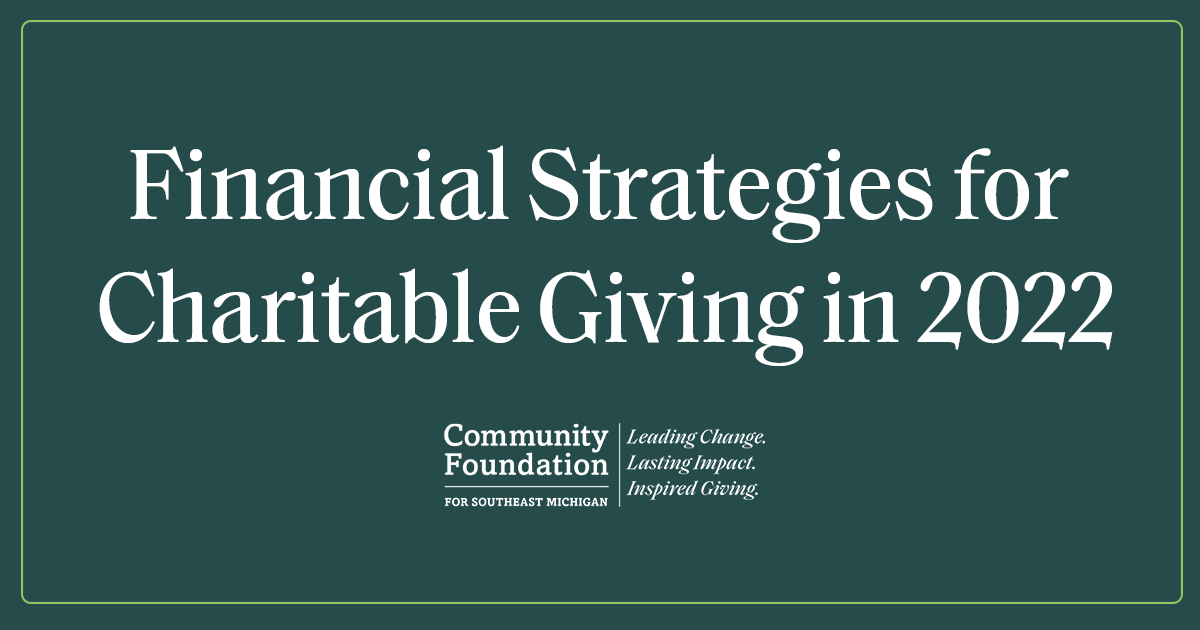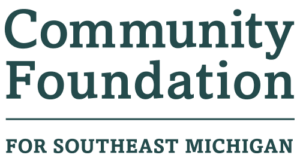3 Tried and True Financial Strategies for Charitable Giving in 2022

For those ready to make philanthropy a priority in 2022, proven strategies are the best bet.
For Americans across the country, the new year represents two things: a chance to review their priorities and set goals for the year, and the start of tax season. While the two may not seem related, when it comes to charitable giving and tax planning, understanding relevant tax policies can help those philanthropically inclined to make the most of their contributions.
At the Community Foundation for Southeast Michigan, we have a long history of working with the charitably minded in our region to make permanent, positive change. For decades, professional financial advisors and donors have trusted us to guide them on how to maximize their giving to the causes they care about. We also stay informed on relevant legislative developments and can offer guidance on how to make a tax-efficient gift to charity.
In November 2021, tax legislation seemed poised to change after the House passed the Build Back Better Bill (H.R. 5376). However, with Senate negotiations stalled, philanthropic donors and their advisors are left in limbo. Without more legislative clarity, many are finding it difficult to develop a plan for charitable giving in 2022.
Despite the uncertainty, there are still charitable giving strategies that work. The following are three strategies that have served donors in our area well for many years and which seem unlikely to be affected by current proposals.
1. Donating stock or marketable securities.
As stock investors know, a dramatic rise in the value of a stock can be a windfall if sold—but it also means paying capital gains tax. Capital gains tax is paid on the profits from the sale of certain types of assets including stock investments. So if someone bought a retail stock in 2020 at $50 per share and it is trading today at $300 per share, if the investor sold the stock today, he or she would have to pay capital gains tax on the $250 difference.
Depending on the investor’s taxable income, the capital gains could be taxed as much as 20% of the profit they made on their stock sale. (If the stock was held for less than one year, the profit would be taxed even higher at ordinary income tax rates.) In the case of the investor above, he would pay $50 to the government and the investor would take home $200. If he wanted to make a donation of the proceeds toward a charitable cause, he could give up to the $200 available after paying the capital gains tax.
Instead, if the investor is charitably inclined, he could donate the stock to a charity. With this strategy, he avoids paying the capital gains tax, and if the investor itemizes, he can claim a charitable income tax deduction for the full fair market value of the stock (up to 30% of adjusted gross income with five year carry forward). With this strategy, the investor is able to support a charity important to him, the charity gets the entire $300 per share, and the investor maximizes tax savings.
2. Making a Qualified Charitable Distribution (QCD).
Individuals who own certain qualified retirement plans who have reached the age of 72 are required to withdraw a certain amount from their plan each year, regardless of whether or not they need the income. This amount, which is known as the Required Minimum Distribution (RMD), is included in their taxable income for the year. A charitably inclined individual is offered an alternative to withdrawing the RMD, paying tax on the distribution, and then giving the net proceeds to charity.
A Qualified Charitable Distribution (QCD) allows an individual over the age of 70 ½* to give up to $100,000 directly to a qualifying charity** without counting the distribution as taxable income. The QCD is available to any individual. Whether he takes the standard deduction or itemized deduction, he can benefit from a QCD. For individuals who do not need their RMD, this is a win-win that provides a tax-free withdrawal while increasing support to charitable causes they care about.
*The age at which individuals are compelled to withdraw RMDs from a qualified retirement plan is age 72. Notwithstanding this age requirement, an individual who has reached age 70 ½ can cause distributions of up to $100,000 to qualify as a QCD.
**Not every charity qualifies for a QCD. To qualify, the charity must be a 501(c)(3) organization and eligible to receive tax-deductible contributions. Private foundations, supporting organizations, and donor advised funds are not qualified charities. However, donors can give to an endowed fund or an unrestricted fund at the Community Foundation.
3. Bunching contributions for maximum tax benefit.
With the increase in the standard deduction, another strategy to maximize tax benefits from charitable donations is bunching. Bunching allows an individual to bunch two, three, or several years’ worth of charitable contributions in one tax year. This ensures that an individual can take the itemized deduction in the tax year in which she bunches, exceeding the standard deduction amount*, and in future tax years, she can take the standard deduction.
* The standard deduction for single filers in 2022 is $12,950, for married couples filing jointly it is $25,900, and for heads of households it is $19,400. Items you can deduct include charitable contributions, mortgage interest, and state and local taxes.
Here is how it works. If an individual who is a single filer gives $5K each year to her favorite charity but is unable to exceed the standard deduction threshold, she could make a gift to her favorite charity in the amount of $15K in one year to take the itemized deduction, and then in the following two years she will take the standard deduction.
Some donors don’t like this strategy because they would prefer to give charities smaller donations over time instead of making several years’ contributions all at once. One way to resolve this is to create a Donor Advised Fund and make a large contribution to it to receive a current year tax deduction. The individual can then recommend grants in subsequent years to her favorite charity, placing her charitable giving in reserve.
For further guidance on charitable giving, contact us.
Our work at the Community Foundation places us in close partnership with professional advisors throughout our region. Many of them rely on us to offer behind-the-scenes consultation to find causes that match their clients’ interests and vehicles that accomplish their clients’ charitable and tax planning objectives. Others prefer we work with their clients directly as philanthropic advisors.
If you would like us to talk to your client about their charitable planning, we are ready to have that conversation. By leaning on our expertise, our partners are able to strengthen their relationships with their clients.
As you prepare goals and taxes for 2022, contact us to learn more about these financial strategies and others that can help make philanthropy a priority this year.

